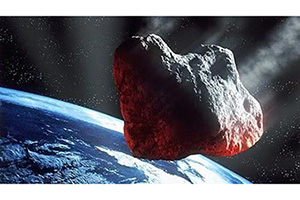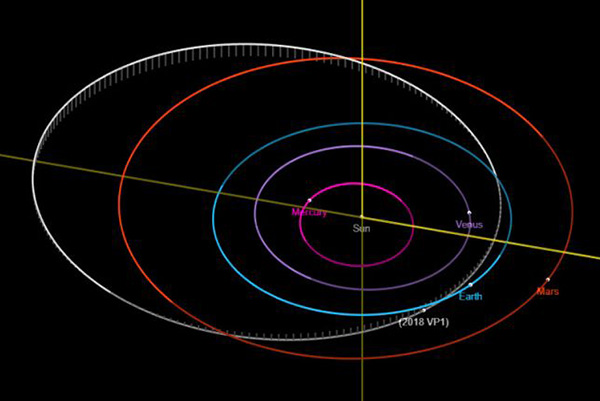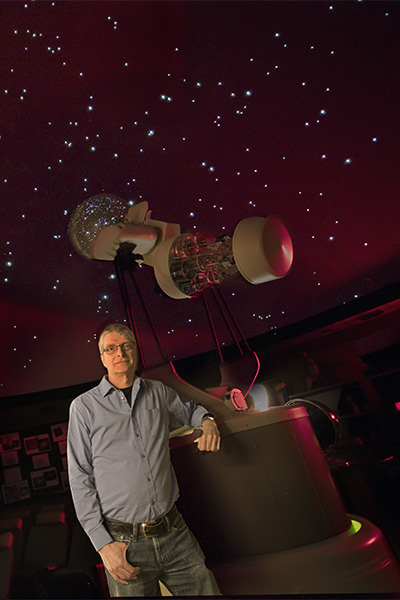- Apply
- Visit
- Request Info
- Give



Published on September 09, 2020

An artist's illustration of an asteroid headed for Earth. Image: ESA
Two weeks ago, television news generated excitement and concern when it reported that a killer asteroid was going to hit Earth on Nov. 2, the day before Election Day. Election Day is going to be interesting enough — imagine the consternation an asteroid could cause!
The excitement subsided when, a couple days later, NASA and the Jet Propulsion Laboratory (JPL) said there was no need to worry. Yes, a small asteroid named “2018 VPI,” about 7 feet in diameter, is headed our way and could arrive on Nov. 2, but they doubt it will hit Earth. NASA and JPL say the asteroid was discovered in 2018 by astronomers using a robotic telescope called the Zwicky Transient Facility on Palomar Mountain in California.
It is not uncommon for asteroids to zoom past Earth; they are typically discovered years before they approach Earth. For instance, another asteroid — 2020 QL2 — is more than 393 feet in diameter and is expected to fly past Earth at a speed of nearly 24,000 mph on Sept. 14. However, it won’t get closer than 4.2 million miles from our home planet. By comparison, the moon is 238,900 miles from Earth.

Eastern’s Robert K. Wickware Planetarium, under the direction Russell Sampson, professor of physical sciences and co-director of the planetarium, is always ready for astronomical activity. Each year, Sampson presents “Eastern Sky Watchers” shows such as “Comet in the Evening Sky,” “Betelgeuse; Orion’s Red Supergiant,” “Peak of the Perseid Meteor Shower” and “Spring Skies and Space Update” to a packed house of area residents, schoolchildren, Eastern students, faculty and staff.
The COVID-19 pandemic has changed Sampson’s plans for this year and the Planetarium is closed until further notice. “For at least the rest of 2020, there will be no public shows, no private shows and no university classes in the planetarium,” said Sampson. “I am teaching all my classes online and will try to keep the community informed on astronomical events through my “Dear Eastern Sky Watchers” email newsletter.”

Sampson is unconcerned about the asteroid interrupting voting in the U.S. elections. “I’m not worried. The asteroid is very small — about the size of a garden shed — and the chances of it hitting the Earth are not very high. Even if it did, most of it would burn up in the atmosphere before hitting any of the candidates in the head. They say it’s too small to do any damage even if it hit Earth head on.”
Sampson explained, “Asteroids and comets have been hitting the Earth ever since there has been an Earth. A large comet or asteroid (about six miles across) appears to have been wholly or partially responsible for the extinction of the dinosaurs some 65 million years ago. These huge impacts occur about every 100 million years.”
As counterpoint, Bill Nye “The Science Guy,” who spoke at Eastern 14 years ago to a standing-room-only audience, thinks people are too complacent about asteroid threats. This past May, Nye warned that catastrophic impacts like the one that wiped out the dinosaurs could happen again. “The problem is, we don’t know when. It’s a very low probability in anyone’s lifetime, but it’s a very high-consequence event. If it happens, it would be like control-alt-delete for everything.”
Sampson says astronomers know the precise orbits of every asteroid larger than about a mile across that could potentially hit the Earth. “These are the asteroids that could cause major regional or global devastation and economic disruption. None of these objects are predicted to hit the Earth in the foreseeable future. Objects smaller than this but capable of causing localized devastation — say a whole city — hit the Earth about once every century. Astronomers have not discovered every object at this scale, but we are working on it.”
Written by Dwight Bachman